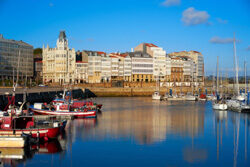La Coruna, Galicia tourist information.
 La Coruna is coastal city located on a rocky peninsula in Northwestern Spain, capital of the A Coruña province and is known as one of Galicia’s most attractive cities. From the medieval “Cidade Vella,” or old town, to the ultra modern 21st century buildings along the water, A La Coruna’s urban layout is stunning and singular.
La Coruna is coastal city located on a rocky peninsula in Northwestern Spain, capital of the A Coruña province and is known as one of Galicia’s most attractive cities. From the medieval “Cidade Vella,” or old town, to the ultra modern 21st century buildings along the water, A La Coruna’s urban layout is stunning and singular.
You can begin your tour to La Coruña following the new promenade along the seashore. The promenade, one of the longest in Europe, will take you to the beaches, Playa del Orzan and Playa Riazor which can be quite crowded on a sunny day. You may stop in Playa del Orzan to visit the Domus Museum or Casa del Hombre (House of Man), a museum that combines Anthropology, Natural History and Science, it also displays interesting interactive exhibitions.
Things to do in La Coruna, Spain
María Píta Square
The square where the Town Hall is situated owes its name to a local heroine, Maria Píta, who saved the city in 1589, sounding the alarm when the English, led by Francis Drake, scaled the walls.
Paseo Marítimo – The seafront promenade
The seafront promenade, that surrounds the peninsula, provides the opportunity of nice strolls. Starting by the La Marina, you can proceed on to the Castelo de San Antón, the Dique de Abrigo, towards the Torre de Hércules, Casa de los Peces, Casa del Hombre, Orzán and Riazor beaches, Millennium monument, and proceed towards the area known as O Portiño, on the flanks of Monte de San Pedro. This last bit of the promenade is outside the main city.
Inner city beaches
The city of A Coruna has several beaches, the first two run below the new city promenade and are called playa del Orzan and playa de Riazor. Both are popular and busy The beach at Orzan and can be easily accessed from the city. These beaches face outwards towards the open sea and the Orzan cove, where they lie, sits behind the headland that separates this area from the main shipping port and marina.
Domus – House of Man Museum
This science and technology museum is home to explorations of humanity and the self, reinvented through interactive exhibits. Domus shines as a source of pride for Galicia. Japanese architect Arata Isozaki designed the Domus complex, which contains a museum, restaurant and IMAX theater, to look like a ship sail.
Teleférico del Monte de San Pedro
The San Pedro Elevator, known as the Teleférico del Monte de San Pedro, is a panoramic lift located at one of the highest points in the city, the San Pedro Mount. Every half hour the spherical glass capsule takes people up and down Mount Pedro, revealing the beauty of A Coruña’s dramatic landscape.
Galicia
Three major ports attest to Galicia’s close relationship with the sea. In the south is Vigo and in the north are La Coruña and the naval base of El Ferrol. Galicia was one of the central points for Western European Megalithic Culture, and physical remains are still visible today. Nonetheless, Galicians trace their cultural ancestry back to Celtic tribes which began to settle around 1000 BC. Celtic Civilisation in Galicia had its heyday between 600 and 25 BC, up to when Galicia fell under the power of the Roman Empire. Still, a weak Romanisation meant the consolidation of a hybrid culture, bearing strong Celtic traits.